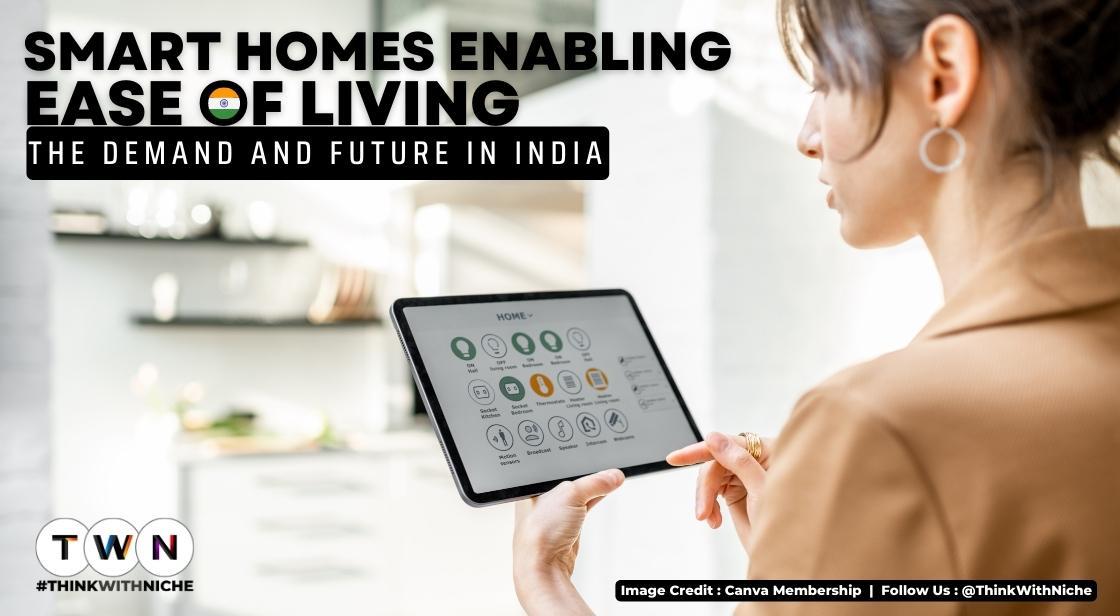Smart Homes Enabling Ease of Living- The Demand And Future In India

Blog Post
Your house may now be monitored and controlled remotely at any time, from anywhere in the globe! Additionally, this device gives you access to a universe that extends well beyond the boundaries of your house. . The ability to remotely operate your complete house is no longer a futuristic technology. Even remote video surveillance of your house or even monitoring of your smart home lights can increase your sense of security.
Live a straightforward and comfortable existence in an autonomous home. Make your home a "Smart Home," turning each switch and appliance into a networked gadget. You may command them with your voice or via an app on your phone. It works with Google Assistant and Alexa devices.
The next big thing in real estate is smart homes. It will determine the direction of real estate. India's newest real estate trend is smart homes. A smart home enhances the home's comfort and leisure. The elderly may also benefit from this. They can turn on a light without getting up from where they are sitting. In this blog post, we will analyze how Smart Homes Enabling Ease of Living in India.
What a typical smart house needs to have Security is the top characteristic that Indians are seeking in a smart home, despite the fact that convenience is one of the reasons for this. To improve a home's security, motion-activated cameras with night vision and video door monitoring are required. Additionally, smart houses have systems in place to detect gas leaks, fires, and intrusions.
The way things are done is greatly influenced by technology, and people have been adjusting to it continually. There is a lot of jargon associated with the "Internet of Things," or IoT, which has gained popularity. Through networks, it links machines together. IoT is essentially new devices becoming connected to the internet in the same way that PCs are.
However, how does it impact how we live? Your alarm goes off. The curtains are opened, and your espresso is prepared in the coffee pot. The water heater is turned on so that the shower has hot water in the meantime, five minutes before your alarm went off. Your refrigerator suggests the breakfast you can make as you walk into the kitchen depending on the items there and reminds you that you need to buy eggs. Every room's TV and lights switch off when you leave the house. In the not-too-distant future, India will likely see a lot of these smart homes.
Smart Homes Enabling Ease of Living- The Demand And Future In India
Automation at Home is a Way of Life
Imagine coffee pots communicating with smartphones and sensors establishing connections with air conditioners. For a seamless experience, we can practically connect any device we can think of to the internet. Our lives will become more pleasant, convenient, and automated due to the Internet of Things, which will also help us save money and energy. Imagine adjusting the air conditioning on a sweltering summer day or having your favorite music and lights switched off when you go to bed.
A system known as Wiser is innovation-driven and effectively blends electrical, multimedia, and telecommunications technology into a single, streamlined intelligent, or smart home solution. By providing seamless management of your music, home theatre, lights, air conditioning, sprinklers, and much more, this smart home automation system makes living comfortable. The user interface is not only easy to use, but it also assists you in ensuring that your system is configured the way you want it to be, which validates the entire purpose of living in an automated home. you can be actively and simply involved due to the wireless platform and the simple language. There won't be any surprises from the installer; just the satisfaction that everything is done precisely how you want it. Wiser positions itself as one of the top home automation devices to turn your regular home into an automated home with an intuitive interface and simple controls.
30% of India's market for smart home automation is made up of commercial areas. This section is primarily responsible for access control and security frameworks. In addition to that dynamic structure, board frameworks are also growing in popularity in India.
Home automation is also used in the neighborliness business, which accounts for 10% of the market. The fields of security and lighting frameworks are also well-known application areas.
Why are people actually required to use clever home appliances?
The answer is simple. People need to live better, more energy-efficient lifestyles that are calmer, and who wouldn't want to have someone helping them manage their houses even more effectively?
What Is a Smart Home?
A smart house is a practical home design where electronics and appliances may be remotely controlled via the internet from any location using a smartphone or other networked device. The internet connects the devices in a smart home, enabling users to remotely control features like temperature, lighting, security access, and home entertainment systems.
Workings of Smart Homes
The gadgets in a smart home are interconnected and accessible from a centralized point, such as a smartphone, tablet, laptop, or gaming console. One home automation system may operate door locks, televisions, thermostats, home monitors, cameras, lights, and even appliances like the refrigerator. The user can set time schedules for specific changes to take effect using the system, which is installed on a mobile device or another networked device.
Self-learning capabilities are built into smart home appliances, allowing them to figure out the homeowner's schedules and make adjustments as necessary. Lighting control in smart homes enables residents to save money on energy costs while using less electricity. When the owner is away from the house, some home automation systems sound an alarm, while others can notify the police or the fire department in the event of an emergency.
Once connected, IoT technology, a network of physical items that can gather and share electronic information, includes services like a smart doorbell, a smart security system, and smart appliances.
Also Read: Know How Digital India Is Enabling Growth For Indian Economy
Smart Home Systems
Both wireless and hardwired technologies, as well as both, are possible in smart homes. The installation of wireless systems is simpler. A wireless home automation system may be installed for several thousand dollars, making it a very affordable option. It includes features like smart lighting, climate control, and security.
The drawback of wireless systems is that you probably require reliable broadband access and excellent Wi-Fi coverage throughout your entire home. You might need to spend money on wireless access points that are hardwired or range extenders. Due to their lower size, wireless smart home systems are typically better suited for smaller existing homes or rental properties.
On the other hand, hardwired systems are thought to be more dependable and often more challenging to hack. A hardwired system may boost a house's resale value. Hardwired smart home systems are very simple to scale, thus when planning a new construction or substantial renovation, this approach is frequently used.
It's relatively pricey, which is a downside. A high-end, hardwired smart system installation can run into the tens of thousands of dollars for homes. Additionally, you need room for ethernet cables and other network gear components.
How to Create a Smart Home
Heating in smart home
Greater control over heating equipment is now possible thanks to smart home items, including the ability to regulate when products are turned on, off, and controlled. If particular conditions are fulfilled, smart goods may be equipped with temperature or humidity sensors to automatically turn on or off. Air conditioners are included in this category of smart home advancements.
Lighting in smart home
Lighting products now improve the capabilities of homes, frequently with the help of a mobile phone, tablet, or specialized remote made specifically for a product. Lights can be turned on and off, put on a schedule, or programmed to change according to the hours of sunrise and sunset. Lights can frequently be configured to change based on motion, just as some more traditional items. Wi-Fi-enabled smart bulbs can talk with one another and send measurements or statistics to your phone.
This lighting category may also include smart home lighting controls or dimmers. It is possible to install automatic blinds and program them to close on sunrise schedules. Electronic drapes, on the other hand, let consumers control their blinds using a portable device.
Audio/Visual in smart home
Many entertainment gadgets are now highly connected to one another and can be managed with a single remote, which is one of the more entertaining features of smart homes. With the help of software, speakers and televisions can now play content on demand and even be voice-controlled or kept on a schedule.
Security in smart home
The improved security features of a smart home are among its most logical features. Nowadays, many products are equipped with cameras that can record video, track motion, or provide live video feeds. This can be programmed to show in certain locations on your property or installed to sync with a ringing doorbell. With the person at your door, these recordings might enable audio-capable video calling.
Modern security kits are also installed in a lot of smart homes. This includes the ability to remotely lock doors or windows using a phone, home monitoring, notifications and alerts of suspicious conduct, and motion sensor detectors when people shouldn't be at home.
Other systems in smart home
Digital assistants or home hubs make up a sizable portion of smart homes. These products can take instructions, answer questions, manage your calendar, plan conference calls, and send alerts. They are frequently used in voice-activated interactions. These digital assistants offer a wide variety of regulating smart assets, their schedules, and their statuses, while not being especially tied to one's house.
Smart smoke and CO detectors can sync to your phone to inform you if you are away from your property in addition to sounding an alarm. These gadgets can frequently be configured to notify certain people in case of emergencies.
For a time now, automated irrigation systems could be programmed. Smart irrigation systems now take climate and environmental factors into account when creating watering plans. Water conservation is a goal of smart irrigation systems, which track moisture-related circumstances.
Conclusion
With the aid of technology and innovation, smart houses facilitate tasks. Smart homes have altered how people do things, consume energy, and connect with their home products, whether it be using your phone to control programs or scheduling products to complete activities at specific times.
You May Like
EDITOR’S CHOICE












